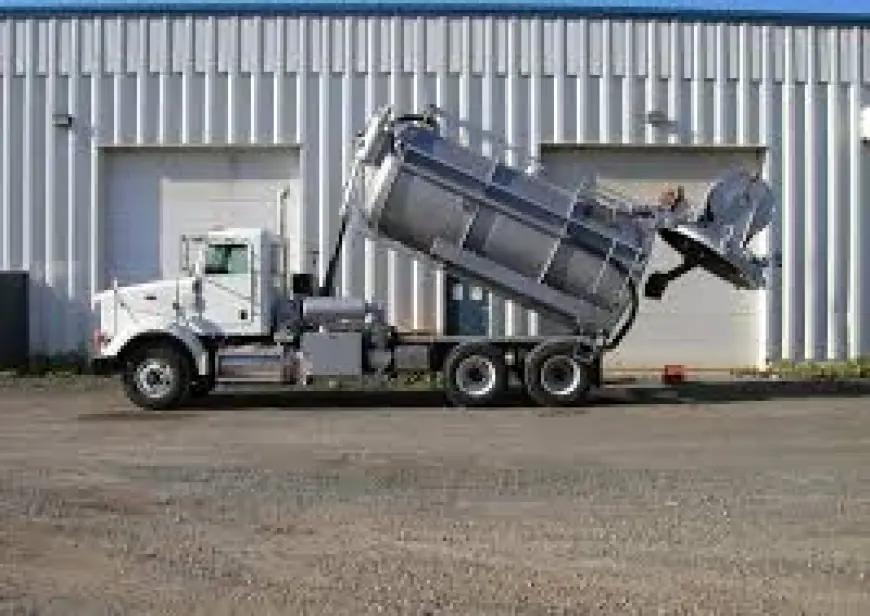Global Vacuum Truck Market 2030F Driven by Sustainability
Technological advancements in vacuum truck designs and functionality are enhancing their appeal to businesses seeking higher productivity.

The global vacuum truck market is entering an era of robust growth, driven by increasing demand for efficient waste management, stricter environmental regulations, and the shift toward eco-friendly, high-performance industrial cleaning equipment. According to industry estimates, the market—valued at USD 1.97 billion in 2024—is projected to reach USD 3.03 billion by 2030, growing at a compound annual growth rate (CAGR) of 7.49% during the forecast period.
From oil fields to city streets, vacuum trucks play an indispensable role in removing waste, sludge, slurry, and hazardous materials, ensuring cleaner environments and safer industrial operations. As industries modernize and urban areas expand, these trucks are no longer just a niche industrial tool—they are becoming a central pillar of sustainable waste management infrastructure.
Industry Key Highlights
- Market Size & Growth: USD 1.97 billion in 2024; projected USD 3.03 billion by 2030 at 7.49% CAGR.
- Main Applications: Oil & gas, construction, chemicals, wastewater treatment, municipal waste management, and emergency spill response.
- Key Growth Drivers: Stricter environmental regulations, technological advancements in waste handling, and urban infrastructure development.
- Product Segmentation: Dry & liquid suctioning trucks and liquid suctioning-only trucks.
- Regional Spotlight: North America remains a growth leader due to stringent waste disposal laws and strong industrial activity.
- Technological Trends: Adoption of hybrid and electric vacuum trucks, energy-efficient engines, low-emission designs, and integrated water recycling systems.
- Challenges: Compliance with diverse regional regulations, high operational costs, and infrastructure limitations for electric truck adoption.
Download Free Sample Report: https://www.techsciresearch.com/sample-report.aspx?cid=21874
Market Overview
Vacuum trucks—often referred to as suction trucks or vacuum tankers—are engineered to handle both liquid and semi-solid waste, using high-powered pumps to extract and store materials for safe disposal or recycling. They have evolved into highly specialized equipment, offering advanced filtration systems, automation features, and eco-friendly propulsion technologies.
The core market drivers stem from industrial sectors such as oil & gas, chemical processing, and municipal services. In urban environments, vacuum trucks maintain sewer lines, storm drains, and sanitation facilities. In industrial contexts, they manage hazardous waste, clean storage tanks, and provide emergency response during chemical spills.
As global environmental policies tighten, industries are under increasing pressure to adopt sustainable waste management solutions—a shift that directly benefits the vacuum truck market.
Market Segmentation Analysis
By Product Type
- Dry & Liquid Suctioning Trucks
These versatile trucks can handle solid debris, sludge, and liquid waste, making them highly suitable for construction sites, oil rigs, municipal cleaning, and industrial facilities. Equipped with multi-stage filtration, separation chambers, and corrosion-resistant tanks, they deliver operational flexibility and cost efficiency. - Liquid Suctioning-Only Trucks
Built for specialized fluid handling, these trucks excel in sewage removal, slurry transport, and hazardous liquid collection. Industries like wastewater treatment and oil recovery prefer these models for their optimized pumping systems and high-capacity tanks.
By Fuel Type
- Internal Combustion Engine (ICE): Currently the dominant category, offering long-range, high-power performance for demanding industrial operations.
- Electric & Hybrid Models: Emerging as a sustainable alternative, particularly in regions with established EV infrastructure.
By Application
- Industrial: Sludge removal, tank cleaning, hazardous waste disposal.
- Excavation: Hydro excavation for safe digging around utilities.
- Municipal: Sewer cleaning, storm drain maintenance, street sanitation.
- General Cleaning: Industrial site maintenance and spill management.
- Others: Disaster recovery, agricultural waste handling.
Emerging Trends in the Global Vacuum Truck Market
1. Rise of Electric and Hybrid Models
With global decarbonization goals accelerating, manufacturers are investing heavily in electric vacuum trucks and hybrid propulsion systems. These vehicles reduce noise pollution, lower emissions, and offer long-term operational savings.
2. Integration of IoT & Telematics
Smart sensors and telematics systems are enabling real-time monitoring of waste levels, predictive maintenance, and route optimization, increasing operational efficiency and reducing downtime.
3. Modular & Customizable Designs
Clients increasingly demand trucks tailored to specific needs—whether for chemical waste, construction debris, or municipal sanitation—driving a trend toward modular tank systems and interchangeable pump assemblies.
4. Water Recycling Systems
Eco-conscious designs now integrate water recycling within vacuum trucks, reducing the need for external water sources during sewer cleaning and hydro excavation.
5. Expansion into Developing Markets
Rapid urbanization in Asia-Pacific, Africa, and Latin America is opening new opportunities, with governments investing in sanitation infrastructure and industrial capacity.
Market Drivers
Environmental Regulations
Governments worldwide are imposing strict waste disposal and emission standards, prompting industries to upgrade to compliant vacuum trucks with low-emission engines and advanced filtration.
Urbanization & Infrastructure Growth
The expansion of metropolitan areas creates demand for efficient municipal waste management solutions, from street cleaning fleets to stormwater management systems.
Industrial Growth & Hazardous Waste Handling
Industries like oil & gas, mining, and chemicals rely on vacuum trucks to meet environmental safety standards and manage hazardous substances responsibly.
Technological Innovations
The introduction of automation, GPS tracking, and IoT systems is improving efficiency and lowering operational costs for fleet operators.
Regional Insights
North America
- Market Leader with strong adoption due to environmental regulations.
- High demand from oil & gas and municipal sectors.
- Growth in electric vacuum truck adoption, especially in urban areas.
Europe
- Focus on low-emission and sustainable solutions.
- Strict waste management directives drive replacement of older fleets.
Asia-Pacific
- Rapid urbanization and industrialization fuel demand.
- Governments investing in sanitation infrastructure.
Latin America & Middle East
- Growing oil & gas exploration and infrastructure expansion present opportunities.
Competitive Analysis
The global vacuum truck market features intense competition, with manufacturers focusing on innovation, compliance, and after-sales service.
Key Players
- Federal Signal Corporation
- Vac-Con (Holden Industries, Inc.)
- KOKS Group bv
- Keith Huber Corporation
- Sewer Equipment Company of America
- Alamo Group Inc.
- Hol-Mac Corporation
- FULONGMA GROUP Co., Ltd.
- Super Products LLC
- GapVax, Inc.
Competitive Strategies:
- Product Innovation: Electric and hybrid models, water recycling technology.
- Geographic Expansion: Targeting emerging markets with affordable models.
- Service Enhancement: Offering maintenance contracts and operator training.
- Sustainability Focus: Compliance with global environmental standards.
Future Outlook
The vacuum truck industry is poised for transformative growth over the next decade, with sustainability, automation, and customization at the forefront. By 2030, electric and hybrid vacuum trucks will likely form a significant share of the market, especially in developed economies.
In developing nations, infrastructure investments will expand the municipal and industrial customer base. Advances in AI-driven fleet management and autonomous driving could further redefine operational efficiency.
10 Benefits of the Research Report
- Comprehensive Market Analysis – Covers global and regional market dynamics.
- Accurate Forecasts – Market size projections up to 2030F.
- Detailed Segmentation – By product type, fuel type, and application.
- Emerging Trends Insights – Identifies technological and market shifts.
- Competitive Intelligence – Profiles of major global players.
- Regulatory Landscape Overview – Summarizes environmental and safety policies.
- Investment Opportunities – Highlights high-growth segments.
- Consumer Demand Patterns – Analyzes industry-specific requirements.
- Strategic Recommendations – Actionable guidance for stakeholders.
- Customizable Data – Adaptable to specific business needs.
Conclusion
The global vacuum truck market is transitioning from a purely functional sector to a technology-driven, sustainability-focused industry. With increasing regulatory pressure, urban infrastructure demands, and industrial growth, vacuum trucks are no longer optional—they are mission-critical for environmental compliance and operational efficiency.
Manufacturers that embrace innovation, eco-friendly designs, and market-specific customization will be best positioned to capitalize on the multi-billion-dollar opportunities that the market presents through 2030 and beyond.
Contact Us-
Mr. Ken Mathews
708 Third Avenue,
Manhattan, NY,
New York – 10017
Tel: +1-646-360-1656
Email: [email protected]
Website: www.techsciresearch.com
What's Your Reaction?
 Like
0
Like
0
 Dislike
0
Dislike
0
 Love
0
Love
0
 Funny
0
Funny
0
 Angry
0
Angry
0
 Sad
0
Sad
0
 Wow
0
Wow
0




















































